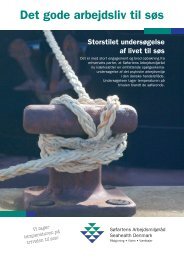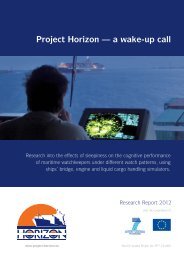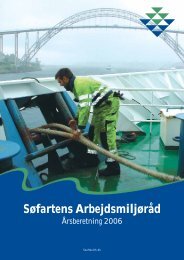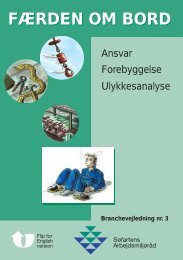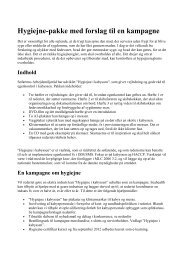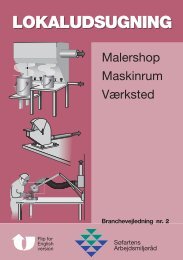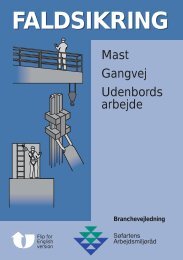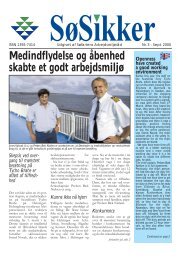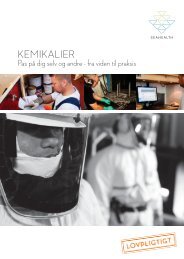POINT EXTRACTION
UK_point extraction2 kor - Søfartens Arbejdsmiljøråd
UK_point extraction2 kor - Søfartens Arbejdsmiljøråd
- No tags were found...
Create successful ePaper yourself
Turn your PDF publications into a flip-book with our unique Google optimized e-Paper software.
Sector specific guidance No. 2<br />
<strong>POINT</strong><br />
<strong>EXTRACTION</strong><br />
Paintshop<br />
Engine room<br />
Workshop<br />
The Danish Maritime Occupational Health Service<br />
2001
Copyright: The Danish Maritime Occupational Health Service<br />
ISBN number 87-986883-8-3<br />
Print: JBK Offset ApS, Ishøj, Denmark<br />
Text: Jens Voxtrup Petersen, CASA and Bjarne Pless, BST Aarhus<br />
Drawings: Pelle Søborg<br />
Production: Tegneriet ApS, Copenhagen<br />
Translation: Joanna Thompson<br />
Published by<br />
Sale and distribution from<br />
Søfartens Arbejdsmiljøråd<br />
Amaliegade 33 B<br />
DK-1256 Copenhagen K<br />
Denmark<br />
Phone: +45 33 11 18 33<br />
Fax: +45 33 11 14 60<br />
www.seahealth.dk<br />
E-mail: info@seahealth.dk<br />
Iver C. Weilbach & Co. A/S<br />
Toldbodgade 35<br />
DK-1253 Copenhagen K<br />
Denmark<br />
Phone: +45 33 13 59 27<br />
Fax: +45 33 93 59 27<br />
E-mail: nautical@weilbach.dk
Why publish sector specific guidance<br />
on point extraction?<br />
Airborne pollution is an undesirable yet unavoidable<br />
consequence of human activities. If a person,<br />
in the course of his work, comes into contact with<br />
harmful fumes or toxic vapours from chemicals, his<br />
health can be adversely affected. Pollution can<br />
have harmful effects on the mucus membranes,<br />
the skin and on breathing. It can cause both acute<br />
effects as well as long-term, chronic effects. Shortness<br />
of breath and loss of consciousness are examples<br />
of acute effects, while asthma, chronic<br />
bronchitis and cancer can be the results of more<br />
long-term exposure.<br />
As a starting point, the law requires that any work<br />
on board a merchant vessel should be carried out<br />
in an entirely appropriate way with regard to health<br />
and safety. This means that persons may not/<br />
should not be exposed to unnecessary harmful influences<br />
that, in either the short or the long term,<br />
can have bad effects on their health.<br />
Consequently, representatives of the shipping industry<br />
have collaborated in preparing this sector<br />
specific guidance. The purpose has been to establish<br />
a form of sound and accepted practice in the<br />
elimination of airborne pollution by means of point<br />
extraction.<br />
The guidelines have been submitted to the Danish<br />
Maritime Authority and any comments are included<br />
in the text.<br />
Legislation<br />
The guidelines are based on the following:<br />
• Legal notice no. 554 of 21st June 2000 on Safety at Sea, with subsequent amendments.<br />
• Directive B from the Danish Maritime Authority on the construction and equipping of vessels etc.<br />
Chapter B II-4: The design and equipping of workrooms and workplaces. 1st January 2001.<br />
• The Danish Maritime Authority’s technical regulation no. 6 of 3rd July 1997: On mechanical extraction<br />
from a closed area used for handling paints, and from workplaces on ships.<br />
Prevention with point extraction and ventilation<br />
The best prevention is naturally to entirely avoid airborne pollution, e.g. by changing the working<br />
process or by changing to other products that do not pollute. A good form of prevention can also be<br />
achieved by eliminating pollution by means of mechanical point extraction. In certain cases it is not possible<br />
to eliminate the pollution in a sufficiently effective way. In these cases, damage to health must be<br />
prevented by the use of suitable personal protection.<br />
Sector specific guidance, The Danish Maritime Occupational Health Service:<br />
Point extraction - Why publish sector specific guidance on point extraction?<br />
3
When should point extraction and room<br />
ventilation be established?<br />
Mechanical forms of point extraction should be designed<br />
to efficiently reduce airborne pollution. It is<br />
not sufficient to reduce airborne pollution to a possible<br />
limit value, if the pollution is actually unnecessary<br />
pollution. Forms of extraction should<br />
be, as far as possible, established in direct connection<br />
to the polluting working process.<br />
Even though extraction is effective, some forms of<br />
pollution on account of their character or of the<br />
character of the working process itself, can bypass<br />
the extraction point and in this way spread to the<br />
working area. This, for instance, can be the case<br />
with welding. In such circumstances, point extraction<br />
should be supplemented with ventilation at the<br />
workplace.<br />
Furthermore, in many situations small widespread<br />
sources of pollution can occur in areas where it is<br />
not reasonable or not possible to establish extraction<br />
at each individual part of the working process.<br />
In such cases, ventilation at the workplace should<br />
also be established.<br />
Air in and air out<br />
Ventilation plants should normally be set up with balanced amounts of air, i.e. that the amount of fresh<br />
air that is introduced corresponds to the amount of air extracted. On the other hand, in workrooms<br />
where it is undesirable to allow airborne pollution from surrounding areas, overpressure should be<br />
maintained, that is to say that more air is blown into the room than is sucked out.<br />
The additional air should ensure an effective replacement of the air that is extracted. The air that is let<br />
in should be fresh and should have a suitable temperature. It would be ideal if the replacement air did<br />
not result in draughts in places where crewmembers are present (the populated zone). By fresh air is<br />
meant here that this should be the best possible exterior air from the surrounding area. The air is taken<br />
into the area in such a way that there is no danger of a short circuit. A short circuit means that the inlet<br />
air (replaced air) would be polluted with air from other sources, e.g. from the funnel.<br />
Explanation of terms<br />
This guideline uses a number of terms, which are also used in the legislation:<br />
• Work room: Any area of the ship where work is carried out, such as on the bridge, engine room, galleys,<br />
control rooms, workshops, paint shops, offices or similar areas.<br />
• Fixed workplace: The place in a work room or other area where work is regularly carried out, such<br />
as at work tables, machines, cleaning basins, pressure test stands, cooking areas and places where<br />
paint is mixed and the relevant working tools are cleaned etc.<br />
• Separate mechanical suction: Mechanical suction systems that are not connected to other ventilation<br />
systems.<br />
• Mechanical point extraction: Extraction that removes airborne particles, vapours and gases,<br />
aerosols and similar forms of pollution as close to the source as possible.<br />
• Unnecessary effects: Effects, which can be considerably reduced in extent and against which it appears<br />
reasonable to initiate preventative measures.<br />
• Open deck: A deck that is entirely open above and on at least two of its sides.<br />
4<br />
Sector specific guidance The Danish Maritime Occupational Health Service:<br />
Point extraction - When should point extraction and room ventilation be established?
Figure 1<br />
Point extraction should provide the air with suitable velocity so that pollution can be trapped and<br />
conducted away from persons (induction speed)<br />
Requirements as to mechanical extraction<br />
• If a working process at a fixed workplace generates<br />
dust, vapours, gases, aerosols or similar,<br />
which are unnecessary, harmful to health,<br />
explosive or irritating in some way, then fixed<br />
mechanical point extraction must be established.<br />
The room should have a supply of fresh<br />
air from an open deck (replacement air).<br />
• Consequently, point extraction should be established<br />
at welding sites, pressure testing<br />
stands, cleaning basins used for the washing<br />
of engine parts, cooking areas in galleys,<br />
large-scale dish washers and similar fixed<br />
workplaces where substances and materials<br />
are handled and the tools used in these<br />
processes are cleaned etc.<br />
• Point extraction should have a suitable induction<br />
speed (away from the person, see figure<br />
1), which is dependent on the type of pollution<br />
in question. The following examples can be<br />
mentioned: Welding 0.5-1.0 metres per second,<br />
cleaning basins (heated and unheated)<br />
0.2-0.5 metres per second, mixing/-cleaning<br />
areas in the paint shop 0.2-0.5 metres per<br />
second.<br />
• At workplaces that cannot be considered<br />
fixed places and where the same effects as<br />
stated under the first point can occur, portable<br />
suction equipment and/or suitable personal<br />
protection should be used.<br />
• The extracted air must be conducted to a free<br />
deck and must not be led back into the work<br />
room or any other rooms on the ship via the<br />
ventilation systems (re-circulation)<br />
• All extraction systems positioned at fixed<br />
workplaces should be equipped with some<br />
form of operational indication that can warn<br />
of insufficient functional ability.<br />
Sector specific guidance The Danish Maritime Occupational Health Service:<br />
Point extraction - When should point extraction and room ventilation be established?<br />
5
How to make point extraction<br />
doors, from the inlet of replacement air etc. It is still<br />
necessary, however, to consider crosscurrents of air<br />
when positioning the tornado.<br />
From a tornado hood, which is 1 meter wide, about<br />
1,000 cubic metres per hour must be extracted in<br />
order to create an induction speed of about 0.25<br />
metres per second.<br />
Extraction duct on a mobile swing arm<br />
Figure 2<br />
An extraction duct (extraction head) can eliminate<br />
pollution in the immediate proximity of the opening<br />
of the duct. This means that it should be relatively<br />
precisely positioned in relation to the source of the<br />
pollution. The question of whether or not the process<br />
generates heat should also be considered.<br />
Figure 3<br />
Tornado<br />
The Tornado system consists of a specially<br />
constructed hood. By means of the positioning of<br />
the extraction and assisted by an air control a horizontal<br />
spiral movement, which is extremely stable, is<br />
created. When the tornado hood is correctly dimensioned,<br />
completely covers the worktable and is<br />
switched on, the necessary air velocity and direction<br />
will be achieved. This applies whatever the<br />
crewmember is engaged in doing, whether the process<br />
generates heat or not, and regardless of at<br />
which part of the table the crewmember carries out<br />
the working process.<br />
The amount of air that can be extracted through<br />
the extraction duct depends on the size of the duct<br />
and the distance to the source of the pollution. In<br />
order to be able to eliminate pollution from a welding<br />
operation at a distance of 30-40 cm or at a mixing<br />
table, the pipe connection to the extraction<br />
duct should be about 160 mm and the volume of<br />
extraction should be about 1,000 cubic metres per<br />
hour. If the extraction duct can be kept at about 10<br />
cm from a welding operation, it would be enough<br />
with a 50 mm pipe, a small extraction duct and a<br />
volume of air amounting to 200 – 400 cubic metres<br />
per hour.<br />
Rear edge extraction (slit extraction)<br />
At a fixed worktable, pollution can be eliminated<br />
with the help of an extraction slit positioned on the<br />
rear edge of the table. Such a slit extractor should<br />
be precisely dimensioned if it is to have the desired<br />
effect. The catch velocity is highest directly over the<br />
table and is rapidly reduced with increased height.<br />
As the tornado consists of a hood with a rear plate<br />
and some side plates, a certain degree of protection<br />
against cross currents is provided, e.g. from open<br />
6<br />
Sector specific guidance The Danish Maritime Occupational Health Service:<br />
Point extraction - How to make point extraction
This method can be quite effective in eliminating<br />
"cold" pollution such as vapours from cold cleaning<br />
basins. The method cannot be used, however,<br />
if heat is generated through the process. Neither is<br />
the method suitable if the source of pollution occurs<br />
slightly above the surface of the table, as for<br />
example, when stirring paint in the large paint containers.<br />
The method is extremely sensitive to<br />
crosscurrents of air.<br />
second should be extracted, corresponding to<br />
about 125 cubic metres per hour per kW. As in the<br />
case of other types of point extraction, extractor<br />
hoods are extremely sensitive to cross currents of<br />
air.<br />
The necessary volume of extraction air depends on<br />
the length of the slit and on the distance between<br />
the work process and the slit, but in general, it<br />
would be between 1,000 and 2,000 cubic metres/per<br />
hour.<br />
Extractor hoods<br />
When heat is generated in connection with pollution,<br />
e.g. at a cooker in the galley, an extractor<br />
hood may be used. The extractor hood should be<br />
positioned so that the distance between the upper<br />
side of the cooker and the lower side of the hood is<br />
as short as possible and the size of the hood<br />
should exceed the size of the cooker by about 25<br />
cm on all free sides.<br />
Figure 4<br />
The necessary extraction volume depends on the<br />
transmission to e.g. the stove. For each kilowatt<br />
supplied to the normal stove, about 35 litres per<br />
Figure 5<br />
Important things to remember:<br />
It is important to be aware of the exact type of pollution that should be eliminated with point extraction.<br />
If it is hot welding fumes, the point extraction must be positioned at a point above the welding site. On<br />
the other hand, if the pollution stems from vapours released by stirring or mixing paint, there is no heat<br />
generated by this process, so it is useless to attempt to eliminate the pollution at a higher point by<br />
means of an extractor hood.<br />
In many engine rooms and workshops, strong currents of inlet air can occur (turbulence). This means<br />
that pollution, regardless of whether it is hot or cold airborne pollution can be spread around the area.<br />
In such areas it is impossible to get point extraction to work efficiently. The still air movement is necessary<br />
in order that point extraction can work effectively and this can be assessed in connection with a<br />
workplace evaluation. A protective screen can solve this.<br />
Sector specific guidance The Danish Maritime Occupational Health Service:<br />
Point extraction - How to make point extraction<br />
7
How to make point extraction<br />
Encapsulation<br />
The most efficient form of point extraction is to encapsulate<br />
the process and make sure that there is<br />
negative pressure within the encapsulation. The<br />
better the encapsulation, the smaller the volume of<br />
air it is necessary to extract.<br />
Re-circulation<br />
In general, all air that is extracted from a polluting<br />
process should be led to the outside and no shortcircuiting<br />
may occur, or the polluted air will be<br />
drawn in again via openings, blowers etc. In many<br />
cases, this means that the outlet air from the engine<br />
room must be conducted up through the casing.<br />
In a few individual cases (e.g. when pressure testing<br />
fuel valves), it is permitted to purify the air and<br />
re-conduct it back into the room (re-circulation). In<br />
other special cases, it may also be permitted to<br />
conduct the polluted air a short distance up inside<br />
the casing, though this requires an exemption from<br />
the Danish Maritime Authority.<br />
Figure 6<br />
Suggestions for point extraction in a paint shop<br />
Efficient point extraction should be established at<br />
fixed work places in the paint shop. This can be<br />
achieved by means of the following:<br />
• Tornado<br />
• Extraction duct<br />
• Rear edge extraction<br />
The tornado principle is the most efficient. When the<br />
tornado hood is positioned over the worktable and<br />
switched on, it will create the necessary air velocity<br />
and air current direction regardless of whether the<br />
operation concerns stirring, mixing or pouring from<br />
one container to another. By employing a worktable<br />
that has been adjusted to different heights, both extraction<br />
and ergonomics (working positions) will be<br />
improved.<br />
An extraction duct can create the necessary induction<br />
speed over a radius of 30-40 cm. This means<br />
that the duct must be placed close to the paint container<br />
and must be moved when pouring from one<br />
paint container to another. As this is not easy for one<br />
person to do in practice, the task is often neglected<br />
and consequently the method is not very effective.<br />
8<br />
Sector specific guidance The Danish Maritime Occupational Health Service:<br />
Point extraction - How to make point extraction
Rear edge extraction can be used for the purpose,<br />
but in many cases it is not sufficient, since in most<br />
cases pollution is not generated at table height but<br />
at a somewhat higher point over the table.<br />
The volumes of extracted air with all three methods<br />
will normally be over about 1,000 cubic metres<br />
per hour, which in most cases will meet the<br />
Danish Maritime Authority’s requirement that the air<br />
in a paint shop should be replaced at least six times<br />
every hour.<br />
As a risk of explosion is present, the electrical<br />
equipment that is used in paint shops should be explosion-proof.<br />
At the same time, it must be possible<br />
to close down the ventilation system from outside<br />
the room. The release button should be placed in<br />
connection with the release for the required firefighting<br />
equipment.<br />
Figur 7<br />
Requirements regarding paint shops and storerooms<br />
A paint shop is an area where paint, organic solvents and non-inflammable liquids are handled and<br />
where used containers are stored. With regard to floor space, the room should be large enough for one<br />
person. In any concrete evaluation of the area, however, the amount of paint used, the types of paint<br />
and whether or not minor repairs are also carried out in the room, will be taken into account. The legislative<br />
requirements include:<br />
• The room must have access from a open deck or a ro/ro deck and should have the required ventilation<br />
as well as being designed for the purpose, including having a free flooring area of at least 4<br />
square metres. (For new ships built after 1st January 2001)<br />
• The workroom for the handling of paint etc. should be equipped with some form of mechanical point<br />
extraction at the fixed workplace. The frequency of air replacement (change of air) in the room<br />
should be at least 6 times per hour.<br />
• Point extraction should have a suitable induction speed of between 0.2-0.5 metres per second at<br />
mixing and cleaning areas.<br />
• Storerooms that are solely used for the storage of paint, organic solvents, inflammable liquids etc.<br />
must be equipped with a form of room ventilation that replaces the air at least 6 times per hour.<br />
Sector specific guidance The Danish Maritime Occupational Health Service:<br />
Point extraction - How to make point extraction<br />
9
Suggestions for extraction in engine rooms<br />
and workshops<br />
Welding in fixed workplaces<br />
The principle requirement to extraction from a welding<br />
operation is that it should create an effective<br />
air movement away from the crewmember towards<br />
the extraction. During the working process, extremely<br />
high temperatures are generated. This<br />
means that the extraction should take place on the<br />
opposite side of the item being welded in relation<br />
to the crewmember and slightly raised over the<br />
welding station. These conditions can be met both<br />
by a tornado or an extraction duct.<br />
Extractor duct<br />
The extractor duct can be mounted on a swing arm<br />
or can be fixed by means of magnets. Depending<br />
on the size, the duct can eliminate pollution from a<br />
welding operation at a distance of between 10 cm<br />
(small duct) and 30-40 cm (large duct), if it is correctly<br />
mounted. In most situations, this will solve<br />
the problem. If the welding operation is of longer<br />
duration, this should be taken into account by<br />
moving the extractor duct along as the welding<br />
operation progresses.<br />
The tornado principle was, in fact, developed for<br />
precisely this purpose. With this principle, the<br />
crewmember does not need to move the point extraction<br />
while he is engaged in welding – as long as<br />
the welding takes place on the side of the worktable<br />
covered by the tornado hood.<br />
Welding at non-fixed workplaces<br />
In the case of welding operations around the ship<br />
(in closed areas or where the air is still), the requirements<br />
as to extraction are the same as mentioned<br />
above.<br />
Figure 8<br />
10<br />
Sector specific guidance The Danish Maritime Occupational Health Service:<br />
Point extraction - Suggestions for extraction in engine rooms and workshops
Figure 9<br />
Mobile extractor<br />
The only possibility of eliminating pollution is to use<br />
a mobile ventilator with flexible hoses and a suitable<br />
extractor duct. It is possible to find ventilators<br />
that can extract a small amount of air at high pressure<br />
and here the small extractor ducts can be<br />
utilised.<br />
There are also other ventilators that can handle<br />
larger amounts of air at a lower pressure, which<br />
means that larger extractor ducts can be used. The<br />
advantage of these larger ducts is that they can<br />
trap pollution at greater distances.<br />
Sector specific guidance The Danish Maritime Occupational Health Service:<br />
Point extraction - Suggestions for extraction in engine rooms and workshops<br />
11
Suggestions for extraction in engine rooms and<br />
workshops<br />
Figure 10<br />
Grinding<br />
The use of grinders causes a great deal of pollution<br />
in the form of cutting and grinding dust as well as<br />
possible gases from the surface treatment operation.<br />
This type of pollution ought to be removed by<br />
means of point extraction.<br />
It is possible to mount various extractor ducts<br />
directly onto the grinder, but they only have a positive<br />
effect if the surfaces being ground are horizontal.<br />
They have practically no effect when welding<br />
edges or when materials are being cut and, in<br />
fact, only get in the way.<br />
During welding, it is necessary to use the extractor<br />
ducts or the tornado principle at the fixed workplaces.<br />
On the other hand, it must be admitted that<br />
neither of these methods can totally eliminate the<br />
pollution. It is important that a breathing apparatus<br />
is always used while carrying out these operations.<br />
should have a filter that prevents the grinding dust<br />
being led into the ducts, as there is a risk that the<br />
ducts and the ventilator could become blocked.<br />
Encapsulation of the grindstone<br />
The grindstone/grinding machine should be encapsulated<br />
as much as possible in order that the<br />
extraction is effective. Many of the machines on<br />
the market are encapsulated and equipped with a<br />
suction pipe. In many cases the encapsulation can<br />
easily be improved.<br />
The necessary amount of air from a disc grinder or<br />
a grinding machine would be about 400 to 1,000<br />
cubic metres per hour, depending on the width and<br />
the encapsulation.<br />
In the engine room or in the workshop, there is often<br />
a disc grinder or a grinding machine. These<br />
should be equipped with point extraction that<br />
12<br />
Sector specific guidance The Danish Maritime Occupational Health Service:<br />
Point extraction - Suggestions for extraction in engine rooms and workshops
Testing of fuel valves<br />
When fuel valves are tested, very small amounts of<br />
extremely fine spray oil fumes can occur. These<br />
must be eliminated before they reach the<br />
crewmember’s breathing zone.<br />
Since the process does not need to take place in<br />
an open area, it should be enclosed and in fact this<br />
is the only correct method of dealing with the<br />
problem.<br />
To implement encapsulation that is more or less<br />
air-free, it is necessary only to remove a very small<br />
quantity of air. Mostly this will be under 100 cubic<br />
metres per hour. This air must be led out into the<br />
open air.<br />
Other polluting working processes<br />
There are other working processes that ought to be<br />
evaluated for the possibility of pollution. One example<br />
is the changing of fuel oil filters where, when<br />
the filter is opened, certain amounts of oil aerosols<br />
can rise up into the crewmember’s breathing zone.<br />
The same thing can happen when, for example,<br />
rotor caps and hot engines are inspected.<br />
One possible solution is to use a mobile ventilator<br />
(the same type as that used when welding) and<br />
lead the air from this to a fixed suction tube. It is not<br />
permitted to re-circulate extracted air, even though<br />
it may have been cleaned through a filter.<br />
One possibility is to use an ejector pump and an oil<br />
filter (the same type that is used in a breathing<br />
apparatus) and subsequently lead the very small<br />
amount of air back into the room. This kind of<br />
equipment is produced by several manufacturers<br />
and in principle is approved by the Danish Maritime<br />
Authority.<br />
Room extraction in general<br />
Since point extraction is not capable of eliminating all the pollution generated by a process, it is always<br />
preferable that there is general extraction in all workshops, testing stations etc. The amount of air that<br />
should be extracted cannot be fixed on a general basis. This will depend on factors such as the process<br />
and on the extent that crewmembers use point extraction.<br />
Sector specific guidance The Danish Maritime Occupational Health Service:<br />
Point extraction - Suggestions for extraction in engine rooms and workshops<br />
13
Suggestions for suction over cleaning<br />
processes<br />
On a ship, there will always be a number of engine<br />
parts etc. that regularly have to be cleaned and this<br />
can be done in several ways.<br />
Washing machines and ultrasound basins<br />
The most appropriate method of cleaning engine<br />
parts etc. is to use closed washing machines, in<br />
which the type of extraction that empties the machine<br />
of hot steam before it is opened, has been<br />
established.<br />
One possibility that has recently become more<br />
widespread is the use of ultrasonic basins. The<br />
cleaning water in these is not so harmful to health<br />
as the oil products that were previously used, and<br />
if the temperature in the basin is kept down to 35-<br />
40 degrees Centigrade, problems should not arise.<br />
The use of compressed air in connection with<br />
cleaning work ought to be reduced to a minimum,<br />
since a normal point extraction is seldom strong<br />
enough to catch the aerosols generated by this.<br />
Ordinary cleaning basins<br />
Point extraction should be established in connection<br />
with the "ordinary" cleaning basins, from<br />
where vapours are released. Since the cleaning liquid<br />
is not heated, the problem can be solved in<br />
various ways:<br />
• Tornado system<br />
• Rear edge extraction (slit extraction)<br />
• Suction funnel<br />
On the other hand, if the temperature is increased<br />
to e.g. 80 degrees Centigrade, which often happens,<br />
the hot steam from the basins could result in<br />
considerable damage to the mucus membranes<br />
and this means that point extraction should be established.<br />
As it is the heat from the heated basins that is the<br />
problem, the only solution is to eliminate the vapours<br />
by means of an extractor fan, or even better,<br />
a tornado hood.<br />
The tornado hood can be established with a relatively<br />
broad slit so that there is still space for a<br />
crane hook to get in over the basin.<br />
An ordinary extractor fan can also be used, but this<br />
is more sensitive to crosscurrents of air and it<br />
should therefore be equipped with plates down to<br />
the basin, preferably on three of the sides.<br />
Figure 11<br />
14<br />
Sector specific guidance The Danish Maritime Occupational Health Service:<br />
Point extraction - Suggestions for suction over cleaning processes
The tornado principle is the most effective. When<br />
the tornado hood is positioned over the basin and<br />
is switched on, the necessary air velocity and<br />
direction will be established. Another advantage<br />
is that it can be equipped with a slit in the front<br />
and top plates, so that a crane hook can get in<br />
over the basin.<br />
A rear edge extractor can also be used, but this is<br />
more sensitive to any cross currents. At the same<br />
time, it is likely that, if the distance from the rear<br />
wall to the front of the basin is relatively large,<br />
then greater amounts of air will have to be used<br />
than with a tornado.<br />
In the case of very small cleaning basins, it is possible<br />
to use an extractor duct placed either on a<br />
swing arm or with magnets.<br />
Figure 12<br />
Suggestion for suction in the galley<br />
In the galley, it is necessary to establish point extraction in the form of an extractor fan over cookers,<br />
deep fryers, ovens etc. See figure 5 and the example on page 20.<br />
The amount of air used should be adapted to the actual consumption. It is not unusual that about 1,000<br />
cubic metres of air per hour is removed from a small galley. In a small room it can be a problem to supply<br />
replacement air without exposing crewmembers to draughts and without the extraction effect being<br />
ruined by cross currents of air.<br />
Sector specific guidance The Danish Maritime Occupational Health Service:<br />
Point extraction - Suggestions for suction over cleaning processes<br />
15
Checking correct functioning and giving<br />
instructions<br />
All extraction systems should be equipped with<br />
operational indications for malfunction. This means<br />
that crewmembers should be able to see whether<br />
suction is in progress and that the system functions<br />
sufficiently well to eliminate the type of pollution<br />
in question.<br />
The crewmembers should be given instructions as<br />
to how these operational indicators work, as well<br />
as instructions on what to do if the extraction is<br />
not sufficient.<br />
Smoke pipettes/ smoke tubes are recommended<br />
for the testing of the efficiency of the suction. The<br />
"cold" smoke is blown out at a typical place of<br />
pollution and the movement of the smoke can be<br />
followed.<br />
Maintenance<br />
Figure 13<br />
The easiest and cheapest method of establishing<br />
an operational indication is to use a U-pipe manometer,<br />
which shows the pressure in the duct<br />
system.<br />
In cases where blocking can occur at the extraction<br />
point e.g. extractor fans, this solution is not<br />
sufficient. Here it is necessary to mount a gauge in<br />
the duct system with a connected U-manometer.<br />
Any form of mechanical point extraction should be<br />
regularly cleaned and maintained. It is recommended<br />
that a drawing of the extractor system<br />
along with data on air volume and inspection routines<br />
should be kept on file.<br />
A supplier should provide detailed and complete<br />
directions for use of a ventilation plant. These<br />
should include the necessary operational and<br />
maintenance instructions as well as a set of main<br />
drawings.<br />
When a large-scale plant is ordered, it should be a<br />
matter of course that the plant is delivered fully<br />
operational with test results that prove that the<br />
plant functions efficiently. This should be checked<br />
before use.<br />
Figure 14<br />
During internal cleaning or repairs to ducts or<br />
similar where harmful substances are released,<br />
each person concerned should use a breathing<br />
apparatus.<br />
16<br />
Sector specific guidance The Danish Maritime Occupational Health Service:<br />
Point extraction - Checking correct functioning and giving instructions
Read more about it<br />
• Legal notice no. 554 of 21st June, with subsequent amendments.<br />
• Directive A from the Danish Maritime Authority. Technical regulation on the working environment on<br />
ships.<br />
• Directive B from the Danish Maritime Authority. Technical regulation on the construction and equipping<br />
of vessels etc. Chapter ll-4 The design and equipping of workrooms and workplaces.<br />
• Directive B from the Danish Maritime Authority. Technical regulation on the construction and equipping<br />
of vessels etc. Chapter ll-1, Construction – building, interior planning and stability, machinery and<br />
electrical equipment, also Chapter ll-2, Construction – fire prevention, discovery and extinguishing of<br />
fires.<br />
• Technical regulation no. 6 of 3rd July 1997 on mechanical extraction from closed areas used for the<br />
handling of paint etc. and from workplaces on ships.<br />
Home pages:<br />
• The Danish Maritime Authority: www.sofartsstyrelsen.dk<br />
• The Danish Maritime Occupational Health Service: www.seahealth.dk<br />
Sector specific guidance The Danish Maritime Occupational Health Service:<br />
Point extraction - Read more about it<br />
17
Examples<br />
Example 1 – Washing machine<br />
This washing machine is equipped with an extractor at the<br />
top. It has been installed in an engine workshop on a Danish<br />
passenger vessel built in 1978. The item to be washed, is<br />
placed in the basket, which is then pushed into the machine.<br />
Large, heavy engine parts can be placed in the washing machine<br />
by means of a running conveyor, so it is not necessary<br />
to lift them.<br />
Example 3 – Encapsulated washing basin<br />
An extractor has also been fitted into the top of this washing<br />
basin. The basin is used for cleaning smaller engine parts in<br />
the engine workshop. The plexi-glass plate closes downwards,<br />
so that steam does not escape into the area. This solution<br />
is also particularly well suited for use in areas with<br />
strong crosscurrents.<br />
18<br />
Example 2 – Encapsulated washing basin<br />
An extractor has been fitted into the top of the encapsulation<br />
on a washing basin. The washing basin, which has been<br />
placed in an engine workshop, is used to clean smaller machine<br />
parts. When something is washed in the basin, the<br />
plexi-glass plate comes down and closes over the basin so<br />
that steam does not escape into the area. This solution is<br />
particularly suitable for areas with strong crosscurrents.<br />
Guidelines for the shipping industry The Danish Maritime Occupational Health Service:<br />
Point extraction - Examples<br />
Example 4 – Pressure testing stand<br />
An extractor has been fitted into the right side of the pressuretesting<br />
stand, which is used to test fuel valves and is positioned<br />
in the engine workshop. The valve is fitted into the top<br />
of the stand and during the testing it is possible to see the<br />
process through the plexi-glass.
Example 5 – Transportable local suction<br />
Transportable local suction can be used in connection With<br />
tasks to be carried out at random places around the ship. It is<br />
particularly suitable for welding jobs outside the welding<br />
workshop or where there is no permanent local suction. In addition,<br />
it can be used to ventilate tanks before entry.<br />
Example 7 – Tornado<br />
This tornado has been installed in a paint shop. One half of the<br />
mixing table can be adjusted in height so that the upper edge<br />
of the paint container is always at the same level, regardless<br />
of whether the container holds 20 litres or 5 litres of paint. The<br />
control air is taken direct from the area, while extracted air is<br />
conducted out into the open air. The tornado screen is<br />
equipped with a u-pipe manometer, so that the operator can<br />
check the efficiency of the extraction process.<br />
Example 6 – Swing-arm extractor with suction duct<br />
This swing-arm with a suction duct has been installed in a<br />
welding workshop. When welding is in progress, the suction<br />
can be adjusted to the best possible position to catch the<br />
fumes containing welding dust.<br />
Example 8 – Grinding machine<br />
This grinder is placed in an engine workshop. A suction duct<br />
has been fitted to the back of the grinder so that part of the<br />
pollution is led away from the operator. It is also a good idea<br />
to utilise the same principle on other similar machines. The<br />
best effect of this suction process is achieved by encapsulating<br />
the grinder/machine as much as possible.<br />
Guidelines for the shipping industry The Danish Maritime Occupational Health Service:<br />
Point extraction - Examples<br />
19
Example 9 – Local suction in the galley<br />
An extractor hood has been fitted over the cooker in the galley.<br />
The extractor hood is about 20 cm larger than the cooker<br />
on all sides, so that pollution is effectively eliminated.<br />
Example 10 – Rear-edge extractor<br />
This washing basins is positioned in the engine room. In order<br />
to have space to submerge large engine parts in the basin, a<br />
rear-edge extractor has been fitted onto the basin. This makes<br />
sure that any pollution is absorbed away from the person<br />
working at the basin.<br />
20<br />
Guidelines for the shipping industry The Danish Maritime Occupational Health Service:<br />
Point extraction - Examples



